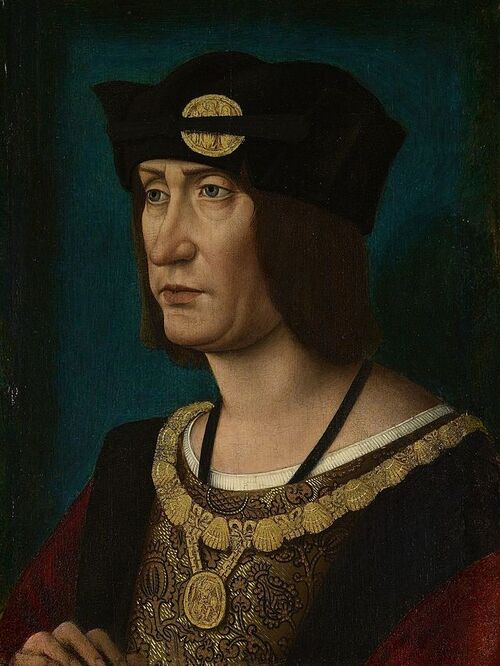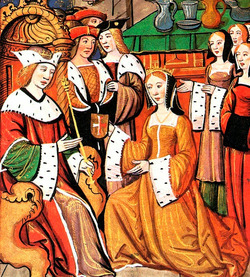-
Today in Tudor History...
27 June 1458 – Death of Alfonso V of Aragon
He was the King of Aragon (as Alfonso V), Valencia (as Alfonso III), Majorca, Sardinia and Corsica (as Alfonso II), Sicily (as Alfonso I) and Count of Barcelona (as Alfonso IV) from 1416, and King of Naples (as Alfonso I) from 1442 until his death. He was one of the most prominent figures of the early Renaissance and a knight of the Order of the Dragon.

1462 – Birth of Louis XII of France , husband of Mary Tudor

Louis XII was a monarch of the House of Valois who ruled as King of France from 1498 to 1515 and King of Naples from 1501 to 1504. The son of Charles, Duke of Orléans, and Maria of Cleves, he succeeded his cousin Charles VIII, who died without a closer heir in 1498.
Before his accession to the throne of France, he was known as Louis of Orléans and was compelled to be married to his handicapped and sterile cousin Joan by his uncle, king Louis XI. By doing so, Louis XI hoped to extinguish the Orléans cadet branch of the House of Valois.
Louis of Orléans was one of the great feudal lords who opposed the French monarchy in the conflict known as the Mad War. At the royal victory in the Battle of Saint-Aubin-du-Cormier in 1488, Louis was captured, but Charles VIII pardoned him and released him. He subsequently took part in the Italian War of 1494–1498 as one of the French commanders.
When Louis XII became king in 1498, he had his marriage with Joan annulled by Pope Alexander VI and instead married Anne of Brittany, the widow of his cousin Charles VIII. This marriage allowed Louis to reinforce the personal Union of Brittany and France.
Louis persevered in the Italian Wars, initiating a second Italian campaign for the control of the Kingdom of Naples. Louis conquered the Duchy of Milan in 1500 and pushed forward to the Kingdom of Naples, which fell to him in 1501. Proclaimed King of Naples, Louis faced a new coalition gathered by Ferdinand II of Aragon and was forced to cede Naples to Spain in 1504.
Louis XII did not encroach on the power of local governments or the privileges of the nobility, in opposition with the long tradition of the French kings to impose an absolute monarchy in France. A popular king, Louis was proclaimed "Father of the People" (French: Le Père du Peuple) in 1506 by the Estates-General of Tours for his reduction of the tax known as taille, legal reforms, and civil peace within France.
Louis, who remained Duke of Milan after the second Italian War, was interested in further expansion in the Italian Peninsula and launched a third Italian War (1508–1516), which was marked by the military prowess of the Chevalier de Bayard.
Louis XII died in 1515 without a male heir. He was succeeded by his cousin Francis from the Angoulême cadet branch of the House of Valois.

1497 – Cornish rebels Michael An Gof and Thomas Flamank are executed at Tyburn, London, England.
1505- Prince Henry, on his father's orders, made secret but formal protest against marriage to his brother's widow. the King was anxious to delay the marriage as he still hoped to find a better match for his son. However, he did not want to formally break off the engagement as he wanted to keep the first instalment of Catherine's dowry which had been paid after her marriage to Arthur.

source:http://www.historyonthenet.com/
1550 – Birth of Charles IX of France

He was a monarch of the House of Valois who ruled as King of France from 1560 until his death. He ascended the throne of France upon the death of his brother Francis II.
After decades of tension, war broke out between Protestants and Catholics after the massacre of Vassy in 1562. In 1572, after several unsuccessful peace attempts, Charles ordered the marriage of his sister Margaret of Valois to Henry of Navarre, a major Protestant leader and the future King Henry IV of France, in a last desperate bid to reconcile his people.
Facing popular hostility against this policy of appeasement, Charles allowed the massacre of all Huguenot leaders who gathered in Paris for the royal wedding at the instigation of his mother Catherine de' Medici. This event, known as the St. Bartholomew's Day Massacre, crippled the Huguenot movement.
Charles sought to take advantage of the disarray of the Huguenots by ordering the Siege of La Rochelle, but was unable to take the Protestant stronghold.
He died without legitimate male issue in 1574 and was succeeded by his brother Henry III.

1556 – The thirteen Stratford Martyrs are burned at the stake near London for their Protestant beliefs.
The Stratford Martyrs were a group of eleven men and two women, who were burned at the stake together for their Protestant beliefs, at Stratford-le-Bow or Stratford near London in England on 27 June 1556, during the Marian persecutions.
A detailed description of the event is in John Foxe's book, The Acts and Monuments.Foxe lists those executed: Henry Adlington, a sawyer of Grinstead, Laurence Pernam, a smith of Hoddesdon, Henry Wye, a brewer of Stanford-le-Hope, William Halliwel, a smith of Waltham Holy Cross, Thomas Bowyer, a weaver of Great Dunmow, George Searles, a tailor of White Notley, Edmund Hurst, a labourer of Colchester, Lyon Cawch, a Flemish merchant of the City of London, Ralph Jackson, a servant of Chipping Ongar, John Derifall, a labourer of Rettendon, John Routh, a labourer of Wix, Elizabeth Pepper of Colchester who was pregnant, and Agnes George of West Bergholt. A further three men, Thomas Freeman, William Stannard, and William Adams, were given a dispensation by Cardinal Pole, the Archbishop of Canterbury for reasons that remain unclear.
The sixteen accused had been brought to Newgate in London from various parts of Essex and Hertfordshire. There, beginning on 6 June 1556, at an ecclesiastical tribunal under the direction of Doctor Darbyshire, the chancellor of Edmund Bonner the Bishop of London, they were charged with nine counts of heresy, to which they all either assented or remained silent. All of them were condemned to death and later published a letter detailing their beliefs in rebuttal of a sermon that had been preached against them by John Feckenham, the Dean of St Paul's. On the 27 June, the remaining thirteen were brought from London to Stratford, where the party was divided into two and held "in several chambers". Here, the sheriff unsuccessfully attempted to persuade each group to recant, by telling them falsely that the other group had already done so
The executions were said to have been attended by a crowd of 20,000. The exact place of the execution is unknown; the most likely site is thought to have been Fair Field in Bow (then known as Stratford-le-Bow), north of the present day Bow Church DLR station.An alternative location is Stratford Green,the last remnant of which became the site of the Parish Church of St John the Evangelist. According to Foxe, "eleven men were tied to three stakes, and the two women loose in the midst without any stake; and so they were all burnt in one fire".

source:wikipedia
